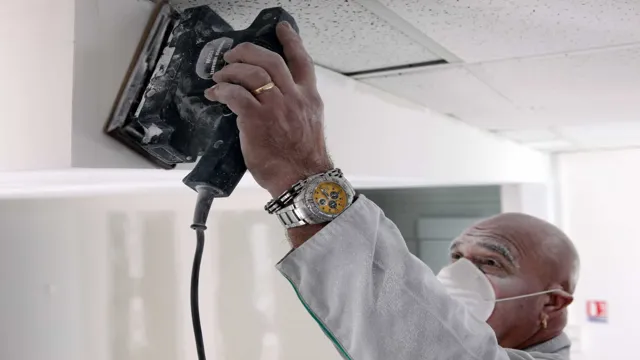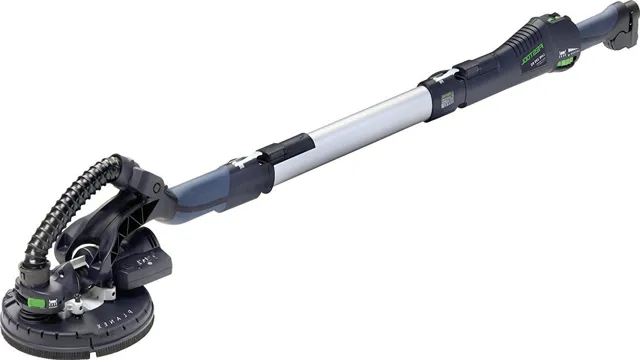Can I Use a Drywall Sander on Wood? Best Practices and Tips

When it comes to refinishing wooden surfaces, it’s certainly a labor-intensive task. However, with the help of technology, we have tools that make the job easier. One such tool is a drywall sander, which you may not have considered using for finishing wood.
In this blog, we’ll break down what you need to know if you’re considering using a drywall sander on wood. From selecting the right sander to tips on using it properly, we’ll cover everything you need to know to create a professional-grade finish on your wooden projects. So, if you’re ready to take on a new task with your drywall sander, read on!
Understanding Drywall Sanders
Many people wonder if they can use a drywall sander on wood. The answer is it depends on the type of sander you have. If you have a sander specifically designed for drywall, it is not recommended to use it on wood.
This is because drywall sanders are designed to be used with drywall compound, which is much softer than wood. Using a drywall sander on wood can cause damage to the wood and may not give you the desired effect you are looking for. However, if you have a sander that is designed to be used on both drywall and wood, then you should be good to go.
Always check the manufacturer’s instructions to make sure the sander is suitable for the material you are working with to avoid any accidents or damage.
Different Types of Drywall Sanders and Their Uses
Drywall sanders are an essential tool when it comes to finishing up your walls. It saves you time and provides you with a smoother surface, making your wall look new again. There are several types of drywall sanders available in the market, each with its unique purpose.
The most common types of drywall sanders include hand-held sanders, pole sanders, and vacuum sanders. Hand-held sanders are compact, lightweight, and commonly used for smaller DIY projects. Pole sanders are perfect for large surfaces, reaching high walls and ceilings effortlessly.
Vacuum sanders come equipped with a built-in dust collection system, keeping your surroundings clean and dust-free while you work. Whether you’re a professional contractor or a DIY enthusiast, understanding the different types of drywall sanders will help you choose the right tool for your project and make your work more efficient.

How Drywall Sanders Work
Drywall sanders are specialized tools that contractors use to smooth out and refine the rough surface of drywall. These sanders work by utilizing a series of sandpaper disks or belts that are attached to a rotating head. The head of the sander moves in a circular motion and vibrates back and forth, which allows the sandpaper to remove small amounts of material from the wall quickly.
Drywall sanders are used to achieve a smooth and even finish on large surfaces, such as walls and ceilings. Compared to manual sanding, drywall sanders are much more efficient, saving contractors a lot of time and effort. By understanding how drywall sanders work, contractors can save time and money while ensuring high-quality results.
Can You Use a Drywall Sander on Wood?
While drywall sanders are primarily meant for sanding drywall, many people wonder whether they can be used on wood too. The answer is yes, you can definitely use a drywall sander on wood as well. In fact, drywall sanders are versatile tools that can be used for a variety of materials, including wood, metal, and even concrete.
However, it’s important to note that drywall sanders may not work as effectively on wood as they do on drywall. This is because the texture and hardness of wood is different from that of drywall. Nevertheless, if you need to sand a large wooden surface or multiple wooden surfaces, using a drywall sander can be a quick and efficient way to get the job done.
Just make sure to use the appropriate grit sandpaper and adjust the speed settings accordingly to achieve the desired results. Overall, a drywall sander can be a useful tool for sanding wood, as long as you use it carefully and correctly.
Yes, But…
“Yes, But…
” Drywall sanders are typically used in the construction industry to smooth out drywall surfaces after installation. However, it’s not uncommon for DIY enthusiasts to use them for sanding wood too. While it’s possible to use a drywall sander on wood, it’s not always the best choice.
One of the reasons is that the sandpaper used on drywall sanders is finer than the one used on regular sanders, making it less effective for removing thick layers of material. Additionally, drywall sanders are not designed to withstand the pressure and force that comes with sanding wood. This can cause the sanding pad to wear out quickly and even break down during the sanding process.
Furthermore, wood dust can clog up the drywall sander, affecting its performance and potentially damaging the motor. In conclusion, while it’s possible to use a drywall sander on wood, it’s not ideal. It’s better to use a specialized sander specifically designed for wood sanding to ensure efficient and effective results.
Factors to Consider Before Sanding Wood with a Drywall Sander
Using a drywall sander might seem like a quick and easy way to sand wood, but it’s not always the best option. While it can be used on wood, there are a few factors to consider before doing so. The first thing to think about is the type of wood you’re working with.
Softwoods like pine or cedar can be sanded with a drywall sander, while hardwoods like oak or maple are much tougher and may require a more heavy-duty tool. Another thing to keep in mind is the grit of sandpaper you’re using. Drywall sanders typically use very fine sandpaper, which is suitable for finishing work on wood, but won’t effectively remove larger imperfections or rough spots.
Additionally, you’ll want to ensure you’re working in a well-ventilated area and wearing a mask to protect yourself from the dust created by sanding. Overall, while you can use a drywall sander on wood, it’s important to carefully consider the type of wood and the specific job you’re trying to accomplish before doing so.
Tips for Sanding Wood with a Drywall Sander
If you’re wondering whether a drywall sander can be used on wood, the answer is yes! However, there are a few things you need to keep in mind before using a drywall sander on wood surfaces. Firstly, it’s important to choose the right sandpaper grit for your particular wood surface. A fine grit sandpaper would work best for thinner pieces of wood while a rougher grit sandpaper is suitable for heavier surfaces.
Always choose a sandpaper that’s compatible with your sander for better results. Additionally, make sure to wear the necessary protective equipment gloves, goggles, face masks, and earmuffs since wood dust can be harmful to your health. Don’t forget to start with low speed setting to avoid causing damage to the wood surface since drywall sanders are high speed.
Overall, utilizing a drywall sander on wood surfaces can save you both time and money, but make sure you follow the above tips for optimal results.
When to Use a Drywall Sander on Wood
While drywall sanders are primarily designed for use on drywall, they can definitely be used on wood as well. However, it’s important to keep in mind that using a drywall sander on wood can be a bit trickier than using it on drywall. The grain and hardness of the wood can affect the sanding process, and you may need to adjust the speed and pressure accordingly.
Additionally, you’ll want to make sure that the grit of the sandpaper is appropriate for the type of wood you’re working with. All in all, if the wood surface is relatively smooth and you’re comfortable using a drywall sander, it can be a great option for giving your surface a nice, even finish. But if the wood is particularly rough or textured, a different type of sander may be a better choice.
Sanding Large Wood Surfaces
If you’re sanding large wood surfaces, you might be wondering if a drywall sander could make your life easier. The short answer is yes, but you’ll want to consider a few things before using one. Drywall sanders are great for large, flat surfaces because they’re designed to cover a lot of ground quickly and easily.
However, they’re typically not recommended for wood surfaces because they can be too aggressive and damage the material. If you’re sanding a rough surface, like a deck or outdoor furniture, a drywall sander might be a great option. But for smoother surfaces, like hardwood floors or cabinets, you’re better off using a dedicated wood sander or sandpaper.
Remember, sanding is all about finding the right tool for the job, so take your time and do your research to get the best results.
Sanding Rough Wood Surfaces
When working with rough wood surfaces, it can be a tough task to achieve the desired finish. While sanding by hand can be a time-consuming process, using a drywall sander may not always be the best approach. However, a drywall sander can be useful when dealing with large or uneven surfaces, providing the necessary power for a smooth and consistent finish.
It’s important to note, though, that drywall sanders are typically designed for use on flat surfaces, so caution should be exercised when using them on various wood surfaces. The best way to determine if a drywall sander is appropriate is to assess the condition and shape of the surface you’re working on, and to apply the appropriate level of pressure and speed when sanding. By doing this, you can avoid damaging your wood surfaces and achieve the desired results seamlessly.
Conclusion
In conclusion, while it may be tempting to extend the use of a drywall sander beyond its intended purpose, using it on wood is like trying to use a screwdriver as a hammer – it might work in a pinch, but it’s not the best tool for the job. Save yourself the headache and invest in a proper sander designed for woodworking – your wood surfaces will thank you, and you’ll achieve better results with less effort.”
FAQs
Can I use a drywall sander on wood flooring?
No, it is not recommended to use a drywall sander on wood flooring as it can damage the surface of the wood.
Can a drywall sander be used for removing paint from wood?
Yes, a drywall sander can be used for removing paint from wood surfaces, but make sure to use the appropriate grit sandpaper to avoid damaging the wood.
Is it safe to use a drywall sander without a dust collector?
No, it is not safe to use a drywall sander without a dust collector as it can lead to excessive dust and debris which can be harmful to your health and safety.
Can a drywall sander be used for sanding metal surfaces?
No, a drywall sander is not suitable for sanding metal surfaces as it is designed specifically for drywall and plaster surfaces.
Can a drywall sander be used for sanding concrete surfaces?
Yes, a drywall sander can be used for sanding concrete surfaces, but make sure to use the appropriate grit sandpaper and take necessary safety precautions.
Can a drywall sander be used for sanding uneven surfaces?
Yes, a drywall sander can be used for sanding uneven surfaces, but make sure to use the appropriate grit sandpaper and take necessary safety precautions.
Can a drywall sander be used for sanding corners and edges?
Yes, a drywall sander can be used for sanding corners and edges, but make sure to use a sanding attachment specifically designed for this purpose.




